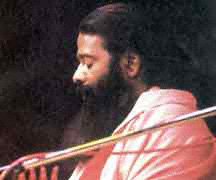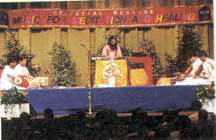- Home
- Archive -Nov 1996
- Ragas of healin. . .

Ragas of healing
- In :
- Personal Growth
November 1996
By Jaya Ramanathan
ri Ganapati Sachchidananda Swami’s music is soothing, meditative and curative
 |
The large gathering sits still, lost in a reverent trance, peace writ large on their faces as the lilt of Nada Brahma wafts across the hall. Though the ambiance in the auditorium is that of a prayer meeting, this is really Sri Ganapati Sachchidananda Swami’s concert; a unique event in that the listeners are here not only to savor the nuanced notes of his devotional music, but, by doing so, to rid themselves of various ailments.
For his is a music that has the power to heal.
At the helm of the concert is the Swami, clad in flowing pink and ochre; his long dark hair merging with his beard. The self-assured Swami speaks in his mother tongue Kannada or Telugu, and occasionally in faltering English. Explaining his curative cadences, he says he delves into the ancient system of using music for healing: ‘There are 72,000 nerves in our body, 14 of which are nerve centers. Each one of these vibrates at a particular frequency. I concentrate on the stomach and the head.’
The Swami combines his music therapy with ayurveda, psychology, gem therapy and astrology. The therapy lays great stress on ekagrata (deep concentration) on the part of the healer/musician and the listener/patient.
Listening, he elaborates, is a technique requiring sense control or indriya nigraha. Listen with your heart and not with your intellect, is his instruction. ‘Cerebral sounds are aroused and long concentration on a raga creates a healing effect on the listener,’ says the Swami, going on to explain his use of different ragas for different health conditions. These are available on audio and video cassettes and can also be bought on ‘prescription’. Certain ragas are particularly curative such as the Sritanjini, Keeravani, Amruthavarshini and Hamsanandhini.
The Swami also prescribes ayurvedic medicines (a family legacy) and hands out gems for constant wear. He does not ask patients to go off allopathic treatment, but to take his prescription as well.
 |
He was born in a poor family. Unable to pursue his studies, the Swami joined the local post office in a remote district in the south Indian sate of Karnataka. His job gave him enough time to compose and sing bhajans, which appeared to come naturally to him. He soon realized it was time to give himself up for his larger vocation—thishe call of God. His mother, who had received initiation from a Muslim fakir, was guru., the incarnation of Brahma, Vishnu and Shiva, became his idol of worship. He then started a small ashram in Mysore.
While regular bhajans are held at Mysore and other ashrams, the highlight of his visit to any city is the concert where the Swami plays a gleaming Roland synthesizer, said to produce the sound equivalent of 1,008 instruments.
Renowned musicians such as L. Subramaniam, T.N. Krishnan and Amjad Ali Khan often accompany him on stage. But the Swami is undoubtedly the star of the show. He decides on which instruments should be played on a particular day, keeping in mind the astrological position of the pancha bhutas, or the five elements, and what is most beneficial for the day’s audience. ‘He also decides which of the ailments he is going to tackle at a concert,’ explains one of his disciples, ‘it may be the heart one day and migraines the next.’
The Swami appears to revel in a sense of intrigue as he stands behind his synthesizer, for only he knows the raga he is going to play. He strikes the first few bars and then goes at it with full gusto as the others pick up the tune. The music does not appear to have a defined beginning or end, after a while it reaches a crescendo, a total fusion of violin, mridangam, flute and synthesizer. The audience is attentive, captivated and then… may be… purged… The music remains at climactic heights for a long time, and then, you are not even aware exactly when, but at some point in time, the Swamileaves the stage, holding a crystal wand (supposedly a stalagmite he discovered in Switzerland). He walks among the audience like a man charged, or in a trance. People prostrate before him. He blesses them, touching them slightly with the wand, and then be walks back to the stage, resuming his music.
And long after the performance is over, Sri Ganapati Sachchidananda Swami’s music, his notes of healing, linger on.
To read more such articles on personal growth, inspirations and positivity, subscribe to our digital magazine at subscribe here
Life Positive follows a stringent review publishing mechanism. Every review received undergoes -
- 1. A mobile number and email ID verification check
- 2. Analysis by our seeker happiness team to double check for authenticity
- 3. Cross-checking, if required, by speaking to the seeker posting the review
Only after we're satisfied about the authenticity of a review is it allowed to go live on our website
Our award winning customer care team is available from 9 a.m to 9 p.m everyday
The Life Positive seal of trust implies:-
-
Standards guarantee:
All our healers and therapists undergo training and/or certification from authorized bodies before becoming professionals. They have a minimum professional experience of one year
-
Genuineness guarantee:
All our healers and therapists are genuinely passionate about doing service. They do their very best to help seekers (patients) live better lives.
-
Payment security:
All payments made to our healers are secure up to the point wherein if any session is paid for, it will be honoured dutifully and delivered promptly
-
Anonymity guarantee:
Every seekers (patients) details will always remain 100% confidential and will never be disclosed
